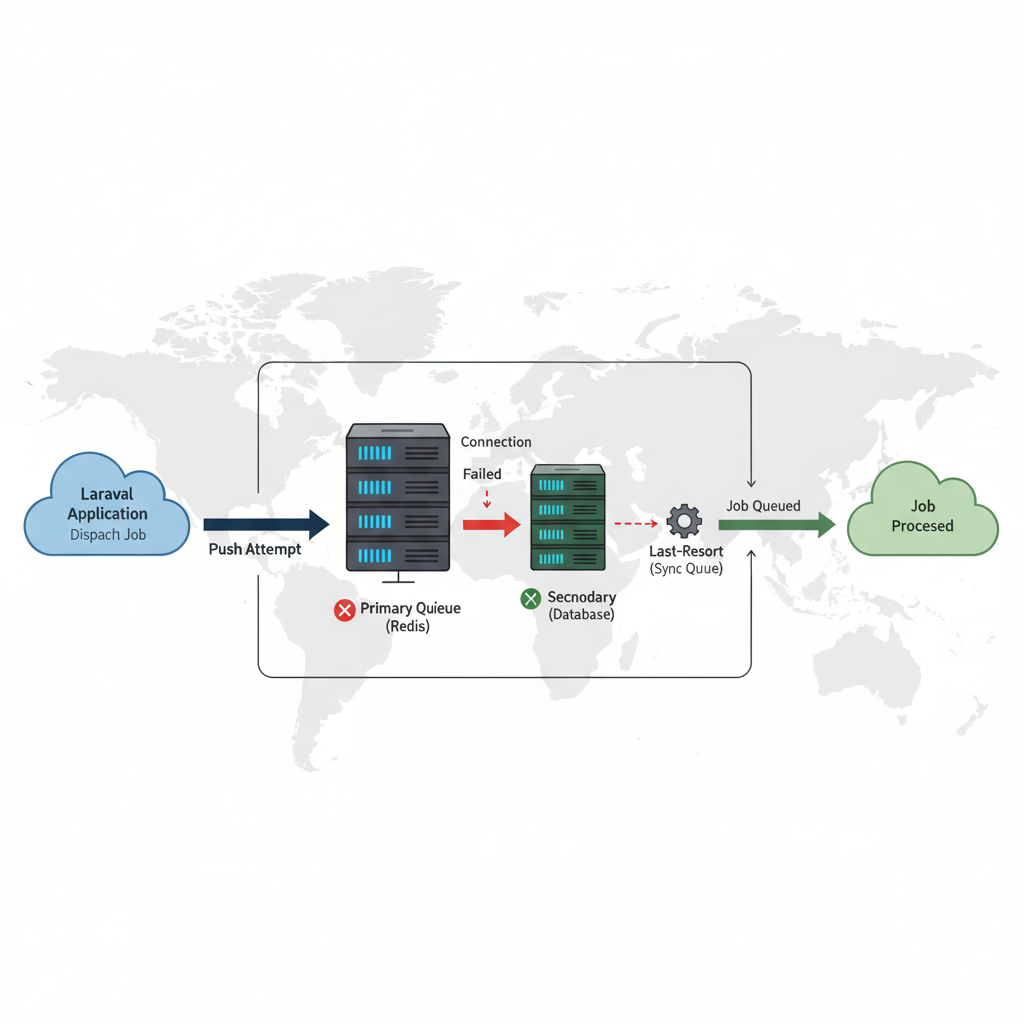- Published on
How to Implement Laravel's Failover Queue Driver for Resilient Queues
- Authors
-
-
- Name
- Jitendra M
- @_JitendraM
-
Table of contents:
-
What Is the Failover Queue Driver?
- How Does It Work?
-
Things to Keep in Mind
- Why Use the Failover Queue Driver?
-
Explore More Topics

If you’ve ever worked with queues in Laravel, you know how important it is that your jobs get processed reliably. A temporary outage on your queue backend can mean lost emails, delayed notifications, or failed background tasks. That’s where Laravel’s failover queue driver comes in—a feature introduced in Laravel 12.34—designed to make your queue system more resilient.
What Is the Failover Queue Driver?
The failover queue driver is a priority-based queue system. Instead of relying on a single backend (like Redis or database), you can define multiple queue connections in a prioritized order. If Laravel fails to push a job to the primary connection, it automatically tries the next one, and the next, until the job is successfully queued or all options fail.
This ensures your jobs are never lost just because your primary backend is temporarily unavailable.
How Does It Work?
1. Define the Connection
In your config/queue.php, define a failover connection listing all the queue connections you want to try:
'connections' => [
'failover' => [
'driver' => 'failover',
'connections' => [
env('QUEUE_CONNECTION', 'redis'), // Primary queue backend (e.g., 'redis')
'database', // Fallback queue 1
'sync', // Last resort fallback
],
],
'redis' => [
'driver' => 'redis',
'connection' => 'default',
'queue' => 'default',
],
'database' => [
'driver' => 'database',
'table' => 'jobs',
'queue' => 'default',
'retry_after' => 90,
],
],
Here, the failover driver will try the primary connection first. If it fails, it falls back to secondary, and finally to sync if all else fails.
2. Dispatch the Job
Once the connection is defined, dispatch your job as usual:
dispatch(new SendWelcomeEmail($user));
Laravel will automatically attempt each connection in the order defined, ensuring your job gets queued even if the primary fails.
3. Monitor with Events
Laravel fires a QueueFailedOver event whenever a job is pushed to a fallback connection. You can listen to this event to log issues or send alerts:
Event::listen(QueueFailedOver::class, function ($event) {
Log::warning("Job {$event->job->getName()} failed on primary, pushed to fallback.");
});
This gives you insight into when your primary queue is having issues.
Things to Keep in Mind
-
Workers Must Be Ready: Failover only helps with pushing jobs, not processing them. Make sure your workers are listening to all potential fallback connections.
You may need separate worker processes:
php artisan queue:work redis
php artisan queue:work database
-
Or configure a single worker to listen to multiple queues, depending on your setup.
-
All Connections Can Fail: If every connection fails when pushing a job, Laravel will throw an exception. Monitoring is still important.
-
Idempotency Matters: Jobs might be queued in different backends. Make sure your jobs are safe to run multiple times if needed.
Why Use the Failover Queue Driver?
- Increased Reliability: Jobs won’t be lost if your primary queue backend is down.
- Minimal Code Changes: You don’t need to rewrite your job dispatch logic.
- Flexible Backend Options: Combine fast but temporary queues with more durable backends to balance performance and reliability.
This is ideal for production systems where job reliability is critical, like sending transactional emails, processing orders, or syncing data. For simpler apps or dev environments, it might be overkill—but it’s a great tool to have in your Laravel toolbox.
Wrapping Up
Laravel’s failover queue driver makes building resilient queue systems simple. By defining a prioritized list of connections, you reduce the risk of lost jobs and keep your background tasks running smoothly—even when the primary backend fails.
Try dispatching a test job using a failover connection and watch Laravel automatically handle the fallback—it’s a small change with a big reliability payoff.
Resource
Check pull request - Click Here